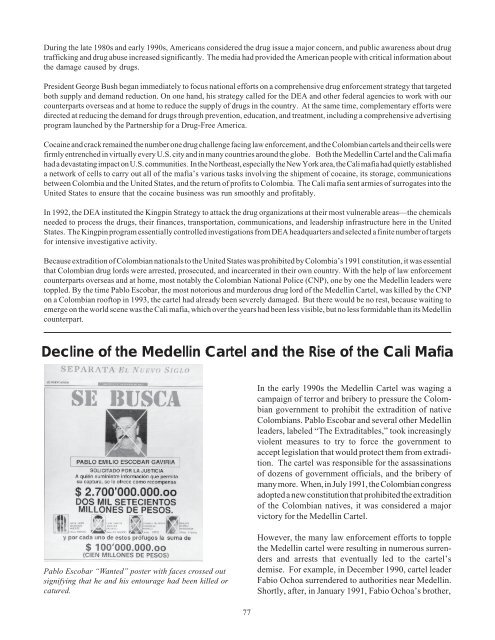Download This File - The Free Information Society
Download This File - The Free Information Society
Download This File - The Free Information Society
You also want an ePaper? Increase the reach of your titles
YUMPU automatically turns print PDFs into web optimized ePapers that Google loves.
During the late 1980s and early 1990s, Americans considered the drug issue a major concern, and public awareness about drug<br />
trafficking and drug abuse increased significantly. <strong>The</strong> media had provided the American people with critical information about<br />
the damage caused by drugs.<br />
President George Bush began immediately to focus national efforts on a comprehensive drug enforcement strategy that targeted<br />
both supply and demand reduction. On one hand, his strategy called for the DEA and other federal agencies to work with our<br />
counterparts overseas and at home to reduce the supply of drugs in the country. At the same time, complementary efforts were<br />
directed at reducing the demand for drugs through prevention, education, and treatment, including a comprehensive advertising<br />
program launched by the Partnership for a Drug-<strong>Free</strong> America.<br />
Cocaine and crack remained the number one drug challenge facing law enforcement, and the Colombian cartels and their cells were<br />
firmly entrenched in virtually every U.S. city and in many countries around the globe. Both the Medellin Cartel and the Cali mafia<br />
had a devastating impact on U.S. communities. In the Northeast, especially the New York area, the Cali mafia had quietly established<br />
a network of cells to carry out all of the mafia’s various tasks involving the shipment of cocaine, its storage, communications<br />
between Colombia and the United States, and the return of profits to Colombia. <strong>The</strong> Cali mafia sent armies of surrogates into the<br />
United States to ensure that the cocaine business was run smoothly and profitably.<br />
In 1992, the DEA instituted the Kingpin Strategy to attack the drug organizations at their most vulnerable areas—the chemicals<br />
needed to process the drugs, their finances, transportation, communications, and leadership infrastructure here in the United<br />
States. <strong>The</strong> Kingpin program essentially controlled investigations from DEA headquarters and selected a finite number of targets<br />
for intensive investigative activity.<br />
Because extradition of Colombian nationals to the United States was prohibited by Colombia’s 1991 constitution, it was essential<br />
that Colombian drug lords were arrested, prosecuted, and incarcerated in their own country. With the help of law enforcement<br />
counterparts overseas and at home, most notably the Colombian National Police (CNP), one by one the Medellin leaders were<br />
toppled. By the time Pablo Escobar, the most notorious and murderous drug lord of the Medellin Cartel, was killed by the CNP<br />
on a Colombian rooftop in 1993, the cartel had already been severely damaged. But there would be no rest, because waiting to<br />
emerge on the world scene was the Cali mafia, which over the years had been less visible, but no less formidable than its Medellin<br />
counterpart.<br />
Decline of the Medellin Cartel and the Rise of the Cali Mafia<br />
Pablo Escobar “Wanted” poster with faces crossed out<br />
signifying that he and his entourage had been killed or<br />
catured.<br />
77<br />
In the early 1990s the Medellin Cartel was waging a<br />
campaign of terror and bribery to pressure the Colombian<br />
government to prohibit the extradition of native<br />
Colombians. Pablo Escobar and several other Medellin<br />
leaders, labeled “<strong>The</strong> Extraditables,” took increasingly<br />
violent measures to try to force the government to<br />
accept legislation that would protect them from extradition.<br />
<strong>The</strong> cartel was responsible for the assassinations<br />
of dozens of government officials, and the bribery of<br />
many more. When, in July 1991, the Colombian congress<br />
adopted a new constitution that prohibited the extradition<br />
of the Colombian natives, it was considered a major<br />
victory for the Medellin Cartel.<br />
However, the many law enforcement efforts to topple<br />
the Medellin cartel were resulting in numerous surrenders<br />
and arrests that eventually led to the cartel’s<br />
demise. For example, in December 1990, cartel leader<br />
Fabio Ochoa surrendered to authorities near Medellin.<br />
Shortly, after, in January 1991, Fabio Ochoa’s brother,

















